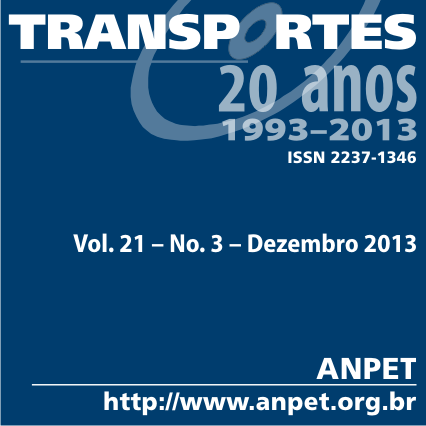AVALIAÇÃO DO EFEITO DE LIGANTES ASFÁLTICOS MODIFICADOS NA RESISTÊNCIA À DEFORMAÇÃO PERMANENTE DE MISTURAS ASFÁLTICAS DENSAS
DOI:
https://doi.org/10.4237/transportes.v21i3.685Abstract
A modificação de ligantes asfálticos é uma prática cada vez mais comum em vias de elevado volume de tráfego e tem como objetivo a melhoria das características reológicas desses materiais, principalmente em temperaturas extremas. O objetivo principal deste trabalho é estudar o efeito de diversos ligantes asfálticos modificados na rigidez e na resistência à deformação permanente de misturas asfálticas densas. Foram estudadas 13 misturas com a mesma granulometria e tipos de agregados e com diferentes tipos de ligantes asfálticos modificados por polímeros e ácido polifosfórico (PPA). A caracterização da deformação permanente foi feita por meio do ensaio de creep dinâmico e das variáveis de densificação CDI e TDIm. Os resultados mostraram que a modificação dos ligantes exerceu um efeito considerável na resistência à deformação permanente das misturas, principalmente naquelas em que foram utilizados ligantes modificados por polímeros. Nessas misturas foi observado que o Flow Number, parâmetro de ruptura do ensaio de creep dinâmico, não foi atingido, mesmo após os 10.000 ciclos previstos para esse ensaio. Verificou-se que os resultados das variáveis CDI e TDIm foram influenciados principalmente pelo teor de projeto das misturas e essas apresentaram um ordenamento diferente do observado nos ensaios de creep dinâmico.
Downloads
References
BAHIA, H.U.; FAHEEM, A. (2007) Using the Superpave Gyratory Compactor to Estimate Rutting Resistance of Hot-Mix Asphalt. Transportation Research Board. Número E-C124 - Practical Approaches to Hot-Mix Asphalt Design and Production Quality Control Testing. Dezembro.
BATES, R.; WORCH, R. (1987) Styrene–Butadiene Rubber Latex Modified Asphalt. Engineering Brief No. 39. Federal Aviation Administration. Washington, DC.
DOMINGOS, M.D.I.; PAMPLONA, T.F.; FAXINA, A.L.; GIGANTE, A.C. (2011) Viscosidade Rotacional de Ligantes Asfálticos Modificados de Mesmo Grau de Desempenho. In: XXV ANPET, Belo horizonte, MG.
DONGRE, R.; D’ANGELO.J.; COPELAND, A. (2010) Refinement of Flow Number as Determined by the Asphalt Mixture Performance Tester for Use in Routine QC/QA Practice. Transportation Research Board, Annual Meeting, Washington, DC. DOI: 10.3141/2127-15
FAXINA, A.L. (2011) Propriedades Reológicas de Ligantes Asfálticos Modificados Virgens e Envelhecidos a Curto Prazo. In: 17ª RPU, Porto Alegre, RS.
GOODRICH, J.L. (1991) Asphaltic Binder Rheology, Asphalt Concrete Rheology and Asphalt Concrete Mix Properties. Asphalt Paving Technology Journal, 80-120.
MAHMOUD, A.F.F.; BAHIA, H. (2004) Using the Gyratory Compactor to Measure Mechanical Stability of Asphalt Mixtures, Wisconsin Highway Research Program. Projeto Número 0092-01-02.
NASCIMENTO, L.A.H. (2008) Nova Abordagem da Dosagem de Misturas Asfálticas Densas com Uso do Compactador Giratório e Foco na Deformação Permanente. Dissertação de Mestrado, COPPE/UFRJ, Rio de Janeiro, RJ.
RODEZNO, M.C.; KALOUSH, K.E.; CORRIGAN, M.R. (2009). Development of a Flow Number Predictive Model.Transportation Research Board 2010 Annual Meeting, Washington, DC. 79-87. DOI: 10.3141/2181-09.
SANDERS, C.A.; DUKATS, E.L. (1992) Evaluation of Percent Fracture of Hot-Mix Asphalt Gravels in Indiana. Effect of Aggregate and Mineral Filler on Asphalt Mixture Performance, R. C. Meininger, American Society for Testing and Materials, STP 1147. Philadelphia, PA.
STIADY, J.; HAND, A.; WHITE, T. (2002) Quantifying Contributions of Aggregate Characteristics Using PURWheel Laboratory Tracking Device. In: Aggregate Contribution to Hot-Mix Asphalt Performance – ASTM STP 1412, 1-15, Orlando, Florida, EUA, Novembro.
WITCZAK, M.W.; KALOUSH, K.; PELLINEN, T. (2002) Simple Performance Test for Superpave Mix Design, National Cooperative Highway Research Program (NCHRP) Relatório 465, Washington, D.C., EUA.
YILDIRIN, Y. (2005) Polymer Modified Asphalt Binders. Construction and Building Materials 21 (2005) 66–72. DOI:10.1016/j.conbuildmat.2005.07.007.
Downloads
Published
How to Cite
Issue
Section
License
Authors who submit papers for publication by TRANSPORTES agree to the following terms:
- The authors retain the copyright and grant Transportes the right of first publication of the manuscript, without any financial charge, and waive any other remuneration for its publication by ANPET.
- Upon publication by Transportes, the manuscript is automatically licensed under the Creative Commons License CC BY 4.0 license. This license permits the work to be shared with proper attribution to the authors and its original publication in this journal, and to be adapted for non-commercial purposes, provided appropriate credit is given and any derivative works are distributed under the same terms.
- Authors are authorized to enter into additional separate contracts for the non-exclusive distribution of the version of the manuscript published in this journal (e.g., publishing in an institutional repository or as a book chapter), with recognition of the initial publication in this journal, provided that such a contract does not imply an endorsement of the content of the manuscript or the new medium by ANPET.
- Authors are permitted and encouraged to publish and distribute their work online (e.g., in institutional repositories or on their personal websites) after the editorial process is complete. As Transportes provides open access to all published issues, authors are encouraged to use links to the DOI of their article in these cases.
- Authors guarantee that they have obtained the necessary authorization from their employers for the transfer of rights under this agreement, if these employers hold any copyright over the manuscript. Additionally, authors assume all responsibility for any copyright infringements by these employers, releasing ANPET and Transportes from any responsibility in this regard.
- Authors assume full responsibility for the content of the manuscript, including the necessary and appropriate authorizations for the disclosure of collected data and obtained results, releasing ANPET and Transportes from any responsibility in this regard.









